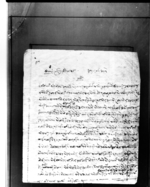A purjī from the Guṭhī Bandobasta Aḍḍā to the Guṭhī Kharca Aḍḍā ordering the disbursement of funds for installing a new Kumārī (VS 1980)
ID: K_0214_0046
Edited and
translated by Astrid Zotter
in collaboration with
Raju Rimal
Created: 2018-10-20;
Last modified: 2019-06-04
For the metadata of the document, click here
The accompanying edition, translation/synopsis and/or commentary are available under the terms of the Creative Commons Attribution-ShareAlike 4.0 International License
Abstract
In this purjī, the Guṭhī Bandobasta Aḍḍā lays out the procedure to be followed to satisfy the claim of the pūjārī Vimalāramaṇa Rājopādhyā to material provisions for installing a new Kumārī in time to worship during Baḍādasaĩ at the Patan Taleju temple and orders the Guṭhī Kharca Aḍḍā to disburse Rs. 20 for what is needed in the attendant feast.Diplomatic edition
[1r]
1⟪12a⟫1श्री५सर्कारतर्फगुठीवंडोवस्तवाट ऐंगुठीषर्चअडाके2पुर्जी•
3ऊप्रांत•पाटंश्रीतलेज्युमावडाडसैकोपुजामारअरुपर्वपर्वमास्मेट्पुजागर्नुपर्नेश्रीकुमारी७६साल्माषु
4न्भैफेर्डागुल्वन्डकोलहंगा१वापत्तातीन्षाप्कोचोलो१लालकपडाकोपछ्यौरा१स्मेट्को
5कौसीतोसाषानावाटमोरु९।२५भोजकोचाहीनेठेकडारवाटमोरु२०।स्मेट्ज्मामोरु२९।२५ष
6र्चगरीस्थापनाभयेको⟪श्रीकुमारीको⟫माहालडाट्झरीषुन्भयाकोलेयो८०साल्कोवडाडसैलाईअर्कोनञाकुमा
7रीस्थापनागर्नुपर्नभयेकोलेजाहेरगरेकोछु•सावीक्वमोजींपाऊभंनेस्मेट्वेहोराकोपुजारीविमला
8रमणराजोपाध्याकोजाहेरीडर्षाष्यस्अडामाडीयेकोलेवुझडाडर्षाष्कावेहोरावाटमोरु२०।भो
9जलाईठेकडारवाटपाऊनेभंनेलेषीयाकोठानेर७७साल्वैसाष१गतेदेषीनेपाल४भंज्यां
10भीत्रकागुठीज्मैअमानट्गर्नुभंनेसवाल्वमोजीं⟪सोगुठीस्मेट्को⟫तेस्अडावाटअमानट्षर्चगरीचलाईआयेकोसोच
11लाऊनालाईठेक्डारवाटषर्चलगट्लीसोलगट्मायेस्अडाकोरगुठीलगट्स्मेट्कोछापलगाईसोष
12र्चकोलगट्तेस्अडामासावीकैपालाचलांभयेकोवुझीनालेषर्चकोकांहुदातेस्अडालाईकौ
13सीवाटपाऊनेमोरु९।२५कोहकमासोहीकौसीतोसाषानालाईलेषीठेकडारवाटपाऊनेभनी
14लेषीयाकोमोरु२०।कोहकमातेस्अडालाईलेषनेकांभयेकोछतसर्थमाठीलेषीयाकोवे
15होरा⟪वुझी⟫वुपीमाथीसोकुमारीफेर्दाभोजकेमोरु२०।वीसरुपैञाडीनुपर्नेलगट्काभयेकोरहेछरऐंस
16वाल्कोल्लेडीनहुनेभयेतेस्अडालाईभयेकासव़ालवमोजींकोरीट्पुर्याईजोगर्नुपर्छगरी⟪नीजपुजारीषर्चहस्तेषर्चडीनेलेषी⟫दीनेकां
17गर•सं८०साल्आश्वींगते रोज्शुभ्म्¯¯¯¯¯¯¯¯¯
Translation
[1r]
12a1
From the Guṭhī Bandobasta [Aḍḍā] under Śrī 5 Sarkāra to the Guṭhī Kharca Aḍḍā under the same
Uprānta: "When the Śrī Kumārī to be worshipped during the pūjā [on the occasion] of Baḍādasaĩ at the Pāṭaṃ Śrī Talejyū [temple] and during other festivals was replaced in the year [VS 19]76 after blood had appeared, the installation ritual was [performed] at a total cost of 29.25 mohararūpaiyā̃s—9.25 morus from the Kausī Tosākhānā for 1 lower garment (lahãgā) of gulbanda2 fabric, 1 three-layered blouse (colo) [made of] bāpatā fabric, 1 headscarf (pachyaurā) of red fabric; together with 20 morus from contractors (ṭhekadāra), which [sum was] needed for the feast. Blood appeared when recently Śrī Kumārī's tooth fell out, [and so] another new Kumārī has to be installed for the Baḍādasaĩ of this year, [VS 19]80, wherefore I [now] inform [you of this]. [I request that I] may receive [the necessary funds] in accordance to what is usual." — The pujārīVimalāramaṇa Rājopādhyā has submitted an application (ḍarṣāṣ for darkhāsta) for approval at our (lit. "this") office (i.e. the Guṭhī Bandobasta Aḍḍa) with the details quoted; [and] when [the application] was being gone over (lit. "understood"), it was determined from the details of the application that 20 morus for the feast are to be received from contractors (ṭhekadāra), [but] according to the administrative regulation (savāla) stating that from the 1st solar day (gate) of the year [VS 19]77 all guṭhīs within the four mountain passes of Nepāla are to follow the amānata-system, covering amānata[-related] expenses through your (lit. "that") office (i.e. the Guṭhī Kharca Aḍḍā) has come to be the procedure now in place including for that guṭhī. In order to carry out the procedure, a list has been received from the [former] contractors and been certified by our office and the Guṭhī Lagata [Jā̃ca Aḍḍā], [and] as that list of expenses has been acknowledged as being the usual practice (pālā-calāṃ) in your office, the task [of the Guṭhī Bandobasta Aḍḍā] is to write to the Kausī Tosākhānā in the case of the claim (haka) to 9.25 morus to be received from the treasury, and to your office in the case of the claim to the 20 morus that have been recorded as having [formerly] been received from contractors.
Since, therefore, in cognizance of the details written above, the 20—[in words], twenty—morus that need to be spent for the feast when this Kumārī is replaced are [properly] registered and to be provided under the law and administrative regulations (ain-savāla), perform the task of writing [down] the expense and putting [the money] into the hands of the said pujārī, [thus] doing what needs to be done to advance a custom that accords with the savālas [valid] for your office.
... day3 , the ...4 solar day (gate) of Āśvina of the [Vikrama] era year [19]80 (1923 CE). Auspiciousness.
Commentary
The scribe of this document, who also seems to have written the related document K_0214_0045, uses the same akṣara (most closely resembling a ḍa) to represent the unanspirated soft stop of both the dentals and retroflexes. For dental -ta, too, at times the -ṭa is used (e.g. in smeṭ, amānaṭ, lagaṭ or rīṭ).
This document is part of a batch of four documents, including the application (darkhāsta) to the Guṭhī Bandobasta Aḍḍā submitted by Vimalāramaṇa Rājopādhyā (K_0214_0044), the documents sent from that office to the Kausī Tosākhānā (K_0214_0045, K_0214_0047) and the present one to the Guṭhī Kharca Aḍḍā. In supporting the claim of the priest for funds to be disbursed for the feast held on the occasion of the installation of a new Kumārī at Patan, the present document explains that since the last occasion for this installation ritual in VS 1976 there had been a change in administrative practice. While back then contractors (ṭhekadāra)—probably persons who held ṭheka contracts for taxes collected from the guṭhī lands in question—were responsible for providing the sum of 20 morus, from the beginning of the year VS 1977 all guṭhīs within the Kathmandu Valley started operating the amānata-system, under which funds were directly provided by state offices. Thus the Guṭhī Kharca Aḍḍā had taken over the responsibility in question and was now ordered to disburse the funds.
For further thoughts on the case at hand, see the Commentaries to K_0214_0044 and K_0214_0045.

